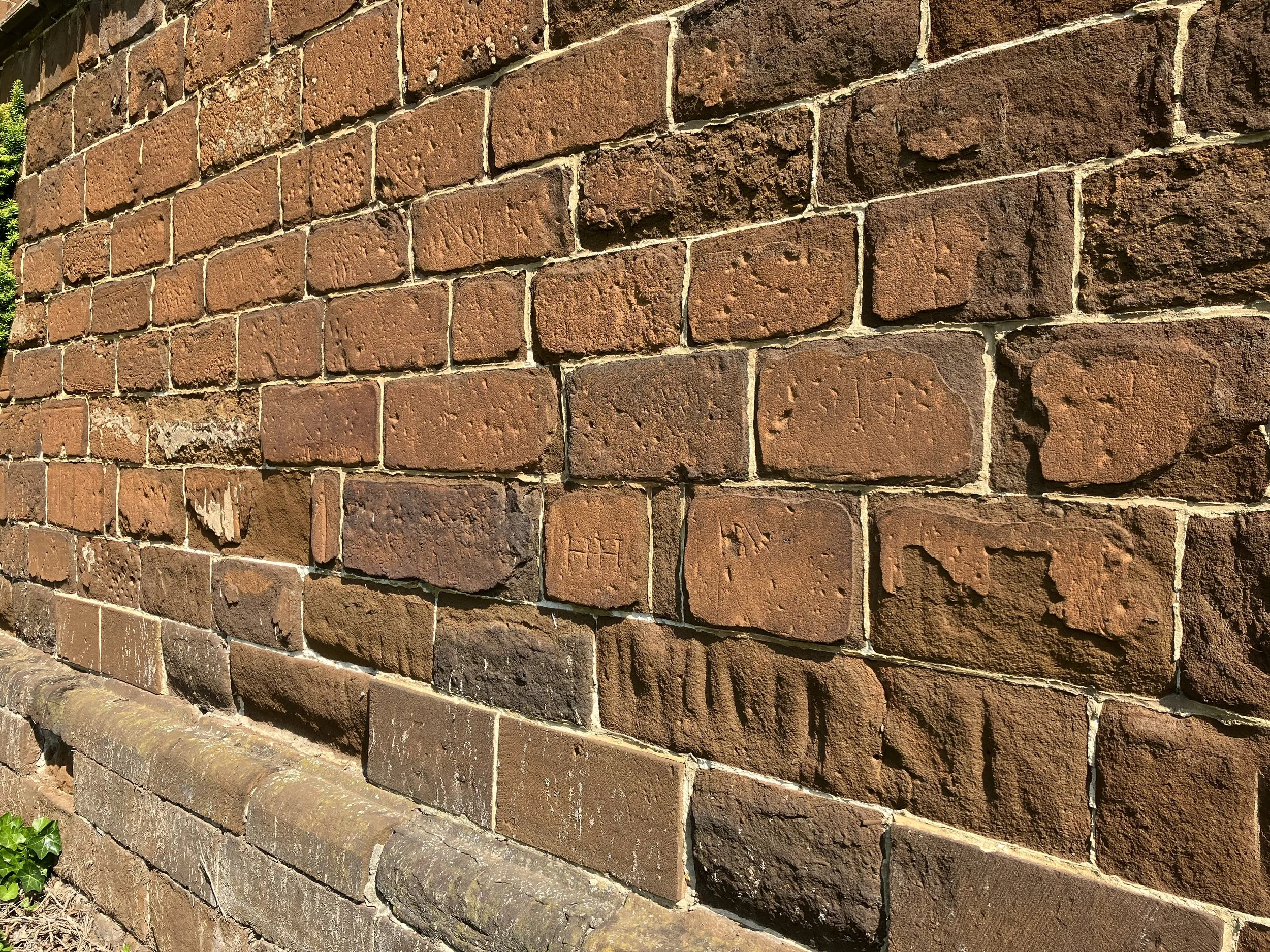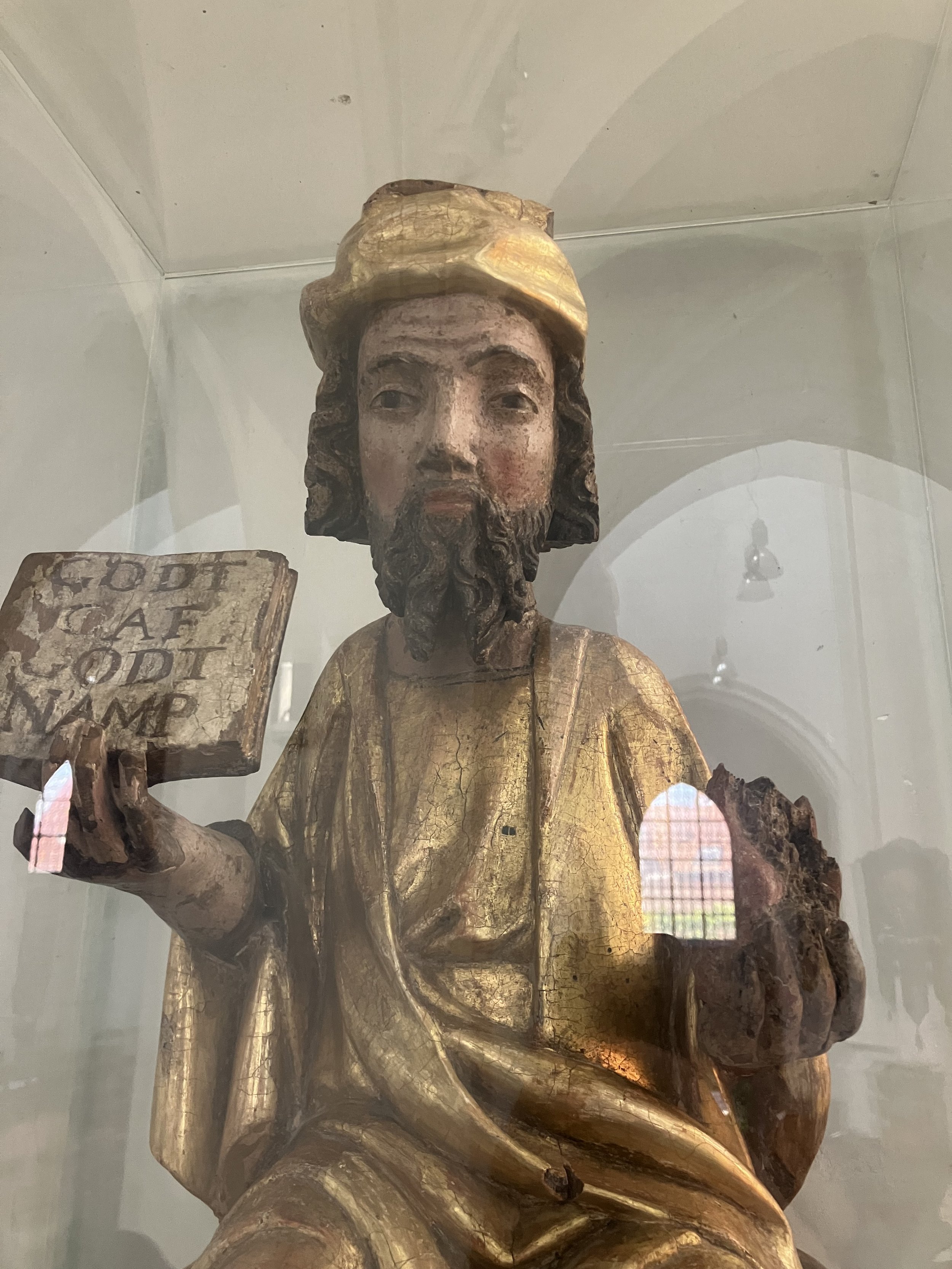EATING SANDSTONE, Eating a stORY: PILGRIMS IN WEZEMAAL
Saint Job. Anonymous, c. 1400–1430, wood. Wezemaal, Sint-Martinuskerk. Photograph: Hannah Gardiner
The wooden statue of Saint Job at Sint-Martinuskerk (Church of Saint Martin) sits within a glass case elevated about five feet off the ground. Job is magnificent — he is handsome and captivating despite being small in size. Miraculously, despite fires, thefts, and the arduous passage of time, this statue of Saint Job remains housed in the village church of Wezemaal, Belgium, which saw its veneration by pilgrims in the late Middle Ages. I had a chance to visit the village church in May and see the wooden statue up close. This powerful work of art attracted thousands of pilgrims seeking out its healing powers, most notably during the syphilis epidemic. Peering down from his glass perch, Job’s face consoles me, as I imagine it consoled many before.
Sint-Martinuskerk is a historically, economically, and theologically interesting site, but my interest in it is one of body — and not just of Job’s. Job’s body in the Book of Job was sick and made well; many pilgrims going to Wezemaal were seeking the same form of redemption. There are pilgrim badges from the site that are round and gold and depict the apocryphal story of Job offering a scab from his body to musicians, only for that scab to turn to gold. As I’ve written about at length, when pilgrims attached these ‘golden scab’ badges to their own bodies, they aligned themselves to the body of Job (and typologically, to that of Christ), embodying his story of redemption and broadcasting the promise of their own.
More bodiliness was to be found in Wezemaal. And this time, a more intense form: that of consumption. Dr. Bart Minnen, the pioneering researcher on the cult of Saint Job in Wezemaal, was kind enough to show me around the church when I visited. The church is full of devotional works of Jobian art from the Middle Ages to the twentieth-century. I remained captivated by the wooden statue, but found myself increasingly curious about what could be found ‘behind’ it: pilgrim marks.
Pilgrim marks (from various centuries) on the exterior iron sandstone bricks of Sint-Martinuskerk. Photograph: Hannah Gardiner.
Visible only from the outside of the church are the marks pilgrims carved into the iron sandstone bricks of Sint-Martinuskerk. According to Dr. Minnen, pilgrims wanted to get as close as possible to the healing statue of Saint Job without touching it. They desired to take home something tangible that had, in some way, come in contact with the sacred object. These pilgrim marks are traces of one way they managed to do this. Pilgrims carved these marks behind Saint Job’s Choir, the south trancept, and the side chapel to its left. These areas of the church — the closest ones to where the statue of Job would have been — are the only ones affected.
Saint Job’s well, located across the gravel road from the church.
Like all sites of pilgrimmage, earth and dust in Wezemaal took on a sacred dimension. Bart Minnen explained to me that pilgrims often carved out dust from the church’s bricks in order to consume it directly or with other substances, such as the healing water of Saint Job’s well, which was located nearby. [1] To be sure, pilgrims did not desire to eat the dust for its own sake, but because of the sacredness it has been infused with by virtue of its proximity to the statue of Saint Job. I find this practice very intriguing. It seems of course similar to the participatory practice of pinning a pilgrim badge onto one’s body, but it goes even further than aligning the body to Job. The power of Job’s story is conferred onto matter in place, which is made almost Eucharistic in the pilgrim’s inviting of it into their bodies.
But why bother eating dust? What does this have to do with pilgrim badges? I explore these questions further in my blog post next week.
—————
[1] Note: information from this paragraph is a translated paraphrase of the information found on this phenonemon in “Devotie in een landelijke bedevaartskerk” in Den Heyligen Sant al in Brabant, volume 1, see page 120. My paraphrase has been supplemented by information Bart Minnen shared on tour at the site, but the ideas presented throughout this paragraph are entirely his own.
Works Cited
Minnen, Bart, ed. Den Heyligen Sant al in Brabant: De Sint-Martinuskerk van Wezemaal en de Cultus van Sint-Job 1000-2000. Volume 1. Averbode, Altiora Averbode, 2011.
Sint-Martinuskerk. Photograph: Hannah Gardiner.
My sincerest thanks to Bart Minnen for taking the time on a Friday morning to show me around Sint-Martinuskerk. His pioneering work on the history of the church is what has enabled me to ask questions about this past and glimpse into it myself.
Written by Hannah Gardiner.




